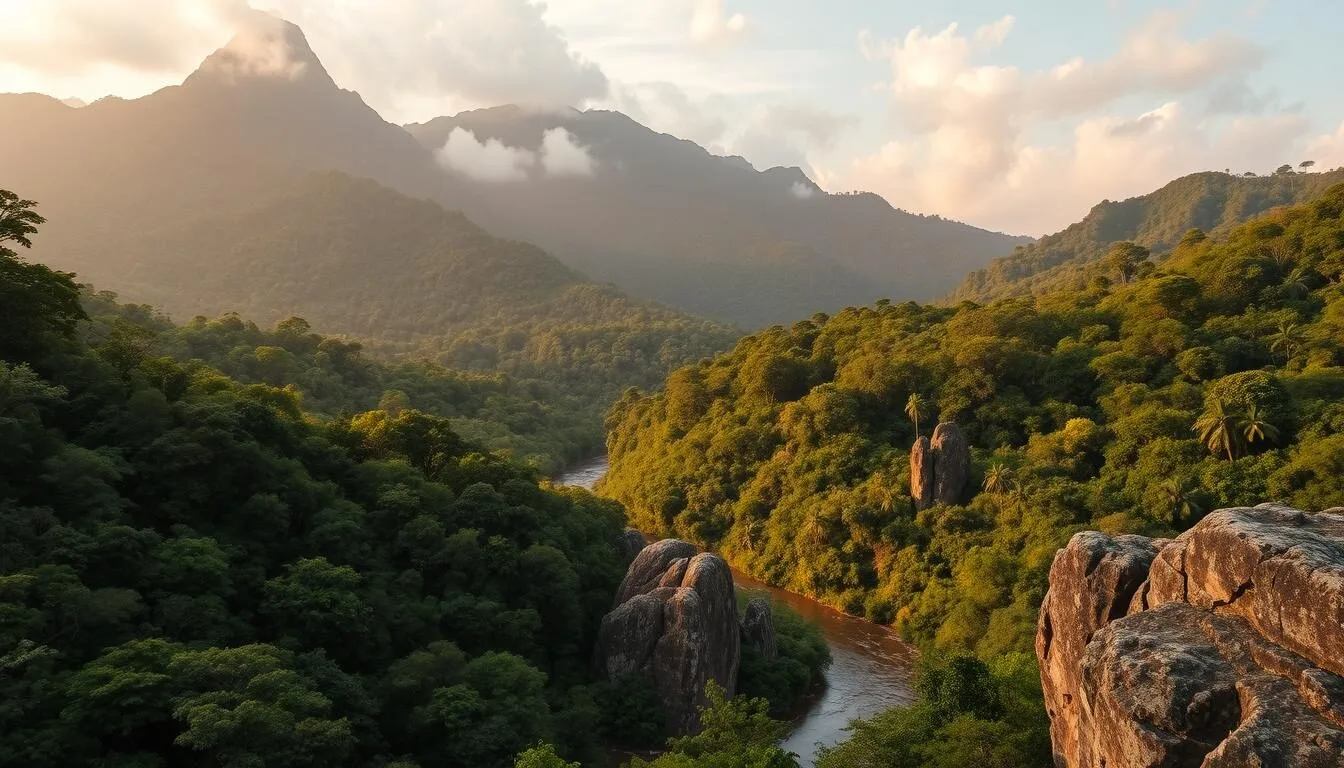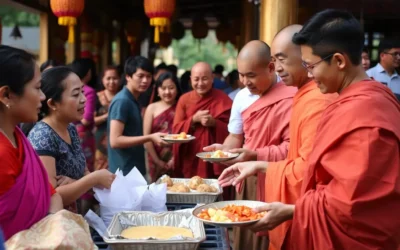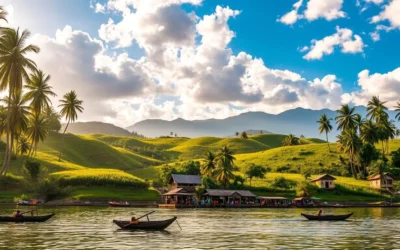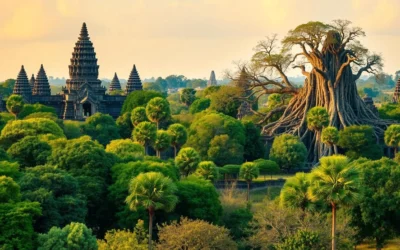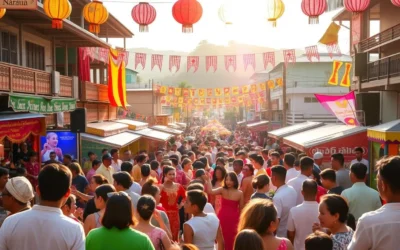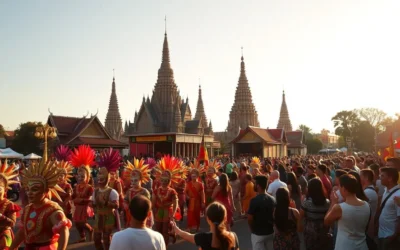✓ Accommodations✓ Flights✓ Rental Cars✓ Tours & Activities
You are about to embark on a journey to the Cardamom Mountains, a vast and biodiverse range in southwest Cambodia that is home to some of the region’s most pristine and untouched ecosystems.
Stretching approximately 300 km long and 70 km wide, this 4+ million-hectare wilderness is a paradise for adventure seekers and nature enthusiasts, offering a rare glimpse into wildlife and ecosystems that have largely disappeared elsewhere in Southeast Asia.
As you explore this destination, you’ll experience the rich nature and diverse wildlife that call the Cardamom Mountains home, from Asian elephants to clouded leopards, and enjoy an experience that is truly off-the-beaten-path.
Discovering Cambodia’s Last Wilderness: The Cardamom Mountains
The Cardamom Mountains, Cambodia’s last great wilderness, offer an unparalleled adventure for nature enthusiasts. As you explore this vast and relatively untouched region, you’ll discover a landscape teeming with life and rich in ecological and historical significance.
Geography and Biodiversity
The Cardamom Mountains are characterized by their diverse geography, which includes dense rainforests, towering peaks, and winding rivers. This varied landscape supports an incredible array of wildlife and species, many of which are found nowhere else in the world. The region’s biodiversity is safeguarded by several large sanctuaries and parks, including Phnom Samkos Wildlife Sanctuary, Phnom Aural Wildlife Sanctuary, and the Southern Cardamom National Park.
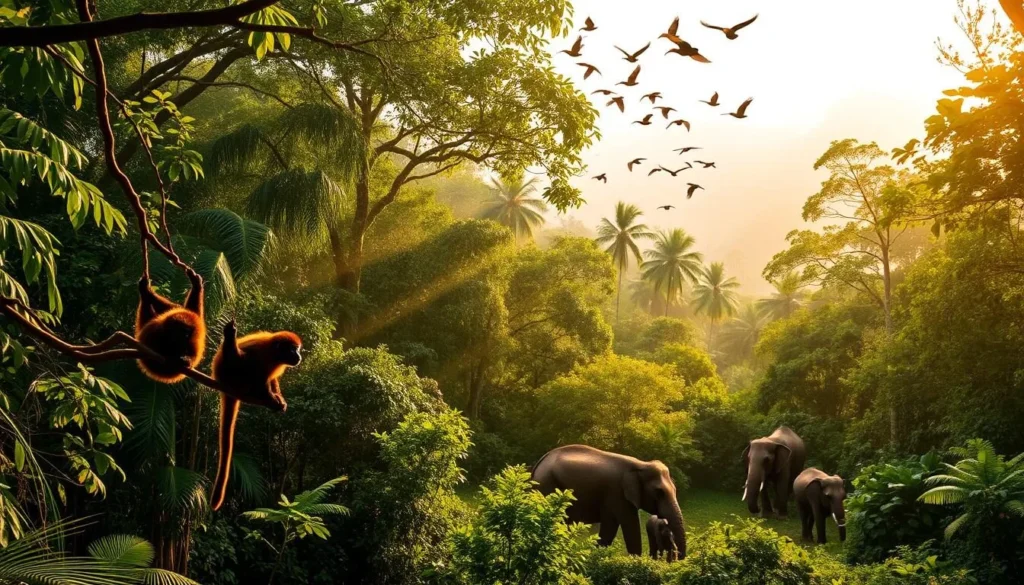
These protected areas form a crucial ecological corridor that allows wildlife to move freely, maintaining healthy animal populations. The conservation efforts in the Cardamom Mountains are multifaceted, involving the protection of approximately 1.7 million hectares of rainforest by Wildlife Alliance rangers.
Historical and Ecological Significance
The Cardamom Mountains have played a significant role in Cambodia’s history, serving as a natural fortress during times of conflict. The region’s difficult terrain and isolation have preserved both cultural traditions and biodiversity. Today, community-based ecotourism initiatives like the Chi Phat project provide sustainable alternatives to logging and hunting for local communities, with a significant portion of tourism revenue going directly to local service providers.
- The Cardamom Mountains have been a refuge during conflicts, preserving cultural traditions and biodiversity.
- Conservation efforts have led to the removal of over 275,000 snares and the rescue of over 7,000 trees since 2002.
- The ecological significance of the Cardamoms extends beyond Cambodia, influencing regional climate patterns and water systems in Southeast Asia.
By visiting the Cardamom Mountains, you’re not only experiencing one of Cambodia’s most pristine environments but also supporting conservation efforts and local communities. The region’s Cardamom Mountains ecosystem is a true natural wonder, worth preserving for future generations.
How to Reach the Cardamom Mountains
To experience the untouched beauty of the Cardamom Mountains, you’ll need to plan your journey carefully. The Cardamom Mountains are Cambodia’s last wilderness, offering a unique adventure for travelers. Planning your trip involves understanding the different routes and transportation options available.
From Phnom Penh
Traveling from Phnom Penh to the Cardamom Mountains involves taking a bus or hiring a private vehicle. The journey can take around 4-6 hours depending on the road conditions and your final destination within the Cardamom region.
From Sihanoukville
If you’re coming from Sihanoukville, you can drive or take a bus to the Cardamom Mountains. The trip takes approximately 3-4 hours, offering scenic views of the Cambodian countryside. This route is ideal for those looking to explore multiple destinations in Cambodia.
From Siem Reap and Other Locations
For travelers from Siem Reap, the journey involves taking a bus to Phnom Penh first, then connecting to another bus or private transport to the Cardamom Mountains. Alternatively, flying from Siem Reap to Sihanoukville or Phnom Penh and then continuing by road is a viable option. Private tour operators can also arrange custom transportation for a more convenient trip.
Best Time to Visit the Cardamom Mountains
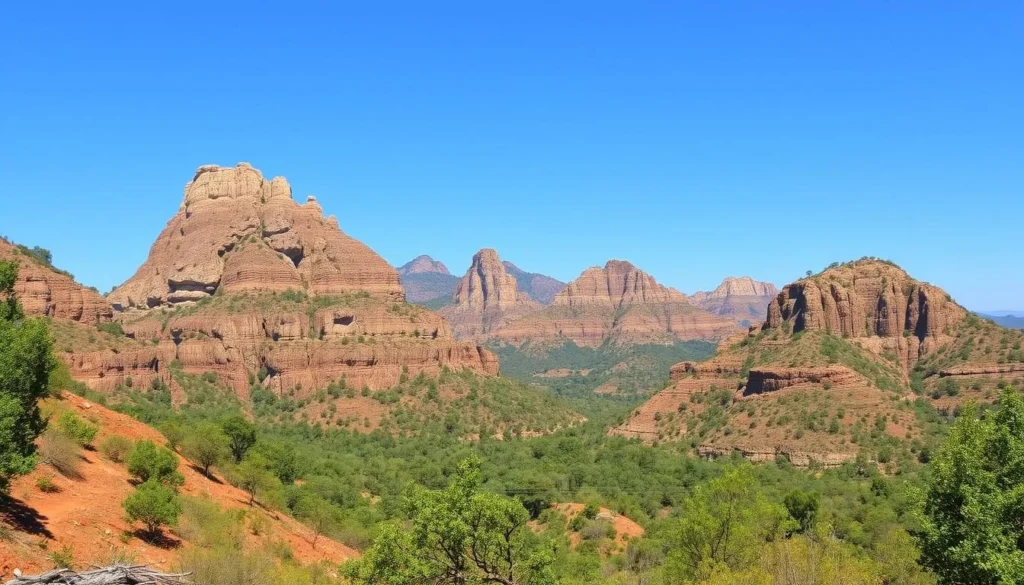
Planning a trip to the Cardamom Mountains requires understanding the best time to visit this Cambodian wilderness. The region experiences two main seasons: the dry season and the rainy season, each offering unique experiences.
Dry Season: November to April
The dry season, from November to April, is characterized by dry and relatively cool weather, making it ideal for trekking and outdoor activities. During this period, the trails are more accessible, and the risk of encountering muddy or slippery paths is significantly reduced.
Advantages of visiting during the dry season include: clearer skies, more comfortable trekking conditions, and better access to remote areas.
Rainy Season: May to October
The rainy season, which spans from May to October, transforms the Cardamom Mountains into a lush green paradise. While the heavy downpours can make some trails impassable, the season offers dramatic scenery and spectacular waterfalls.
- The forest becomes vibrant and lush.
- Waterfalls are at their most spectacular volume.
- Lower prices on accommodations and fewer tourists.
- Ideal for photographers seeking dramatic skies and powerful waterfalls.
- Budget travelers can benefit from significant discounts.
To navigate the challenges of the rainy season, it’s essential to pack appropriate gear, including waterproof clothing and sturdy hiking boots, and consider hiring a local guide.
Top Trekking and Hiking Adventures
The Cardamom Mountains offer some of the most exciting trekking and hiking adventures in Southeast Asia. With diverse landscapes, from dense jungles to montane ecosystems, and a rich variety of wildlife, this region is a paradise for outdoor enthusiasts.
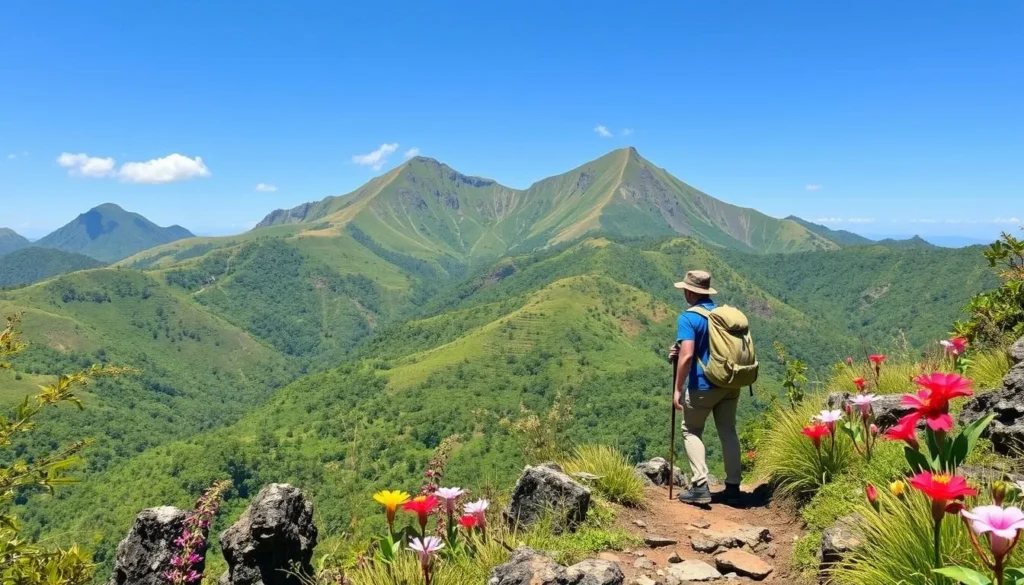
Phnom Aural Trek
The Phnom Aural Trek is a challenging adventure that takes you to the highest peak in Cambodia. The trek offers breathtaking views of the surrounding landscape and the opportunity to spot rare wildlife. You’ll trek through dense forests and experience the unique biodiversity of the Cardamom Mountains.
Chi Phat Community Trails
The Chi Phat Community Trails offer a more relaxed trekking experience, with scenic views of the surrounding countryside. This community-based tourism initiative allows you to engage with local communities and experience their traditional way of life. The trails take you through a mix of forests, villages, and agricultural landscapes.
Phnom Samkos Wildlife Sanctuary Hikes
The Phnom Samkos Wildlife Sanctuary is a protected area that offers some of the most pristine hiking trails in Cambodia. The sanctuary is home to a wide range of wildlife, including Asian elephants, pileated gibbons, and clouded leopards. Multi-day treks involve camping in designated areas, allowing for an immersive experience in this remote wilderness.
Whether you’re an experienced trekker or just looking for a new adventure, the Cardamom Mountains have something to offer. With their rich biodiversity, diverse landscapes, and opportunities to engage with local communities, these trekking and hiking adventures are sure to leave a lasting impression.
Spectacular Waterfalls in the Cardamom Mountains
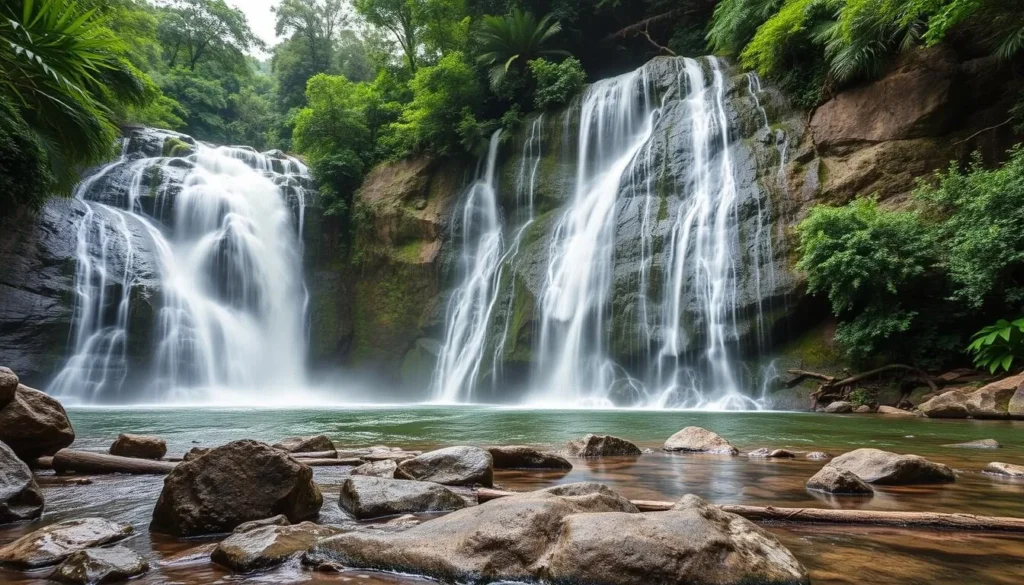
As you explore the Cardamom Mountains, you’ll discover a series of spectacular waterfalls. The region is home to many breathtaking cascades, each offering a unique adventure and a chance to experience the natural beauty of Cambodia.
Tatai Waterfall
The Tatai Waterfall is one of the most accessible and scenic waterfalls in the Cardamom Mountains. Located on the Tatai River, it features a two-tiered drop that is 5-15 meters high. You can reach the waterfall by taking a 20-30 minute boat ride from Tatai town.
Other Notable Cascades
Beyond Tatai, the Cardamom Mountains hide numerous other spectacular waterfalls that reward adventurous travelers willing to trek deeper into the wilderness. Some notable mentions include:
- Chhay Areng Waterfall, accessible via jungle trails from Chi Phat, offers a secluded experience with multiple tiers of cascading water.
- O’Malu Waterfall, another gem in the Chi Phat area, features a series of pools perfect for swimming after a moderately challenging 7-8 km trek.
- The waterfalls near O’Soam village provide refreshing swimming opportunities and serve as important gathering places for local communities.
These lesser-known waterfalls require guides and sometimes overnight camping to reach, but the effort is rewarded with completely private swimming spots and untouched natural beauty.
Wildlife Watching and Nature Experiences
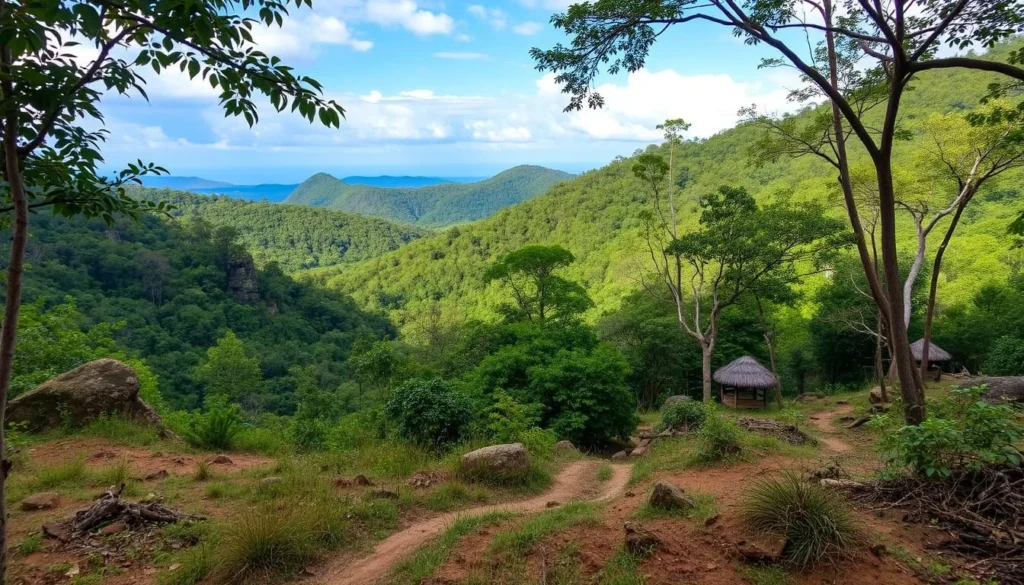
With its rich biodiversity, the Cardamom Mountains are an ideal destination for those seeking immersive wildlife experiences. The region is home to a wide variety of flora and fauna, making it a paradise for nature lovers and wildlife enthusiasts.
Rare Species to Spot
The Cardamom Mountains are renowned for their diverse wildlife, including several rare and endangered species. Visitors can spot otters, peafowl, and hornbills along the rivers and in the forests. The region’s untouched wilderness provides a habitat for numerous other species, making every wildlife watching experience unique.
Guided Wildlife Tours
Guided tours are an excellent way to explore the Cardamom Mountains’ wildlife. Expert guides lead wildlife tours that take you through the forests and along the rivers, providing insights into the region’s ecology and helping you spot elusive species. These tours often include visits to wildlife release stations and bat caves, enhancing your understanding of conservation efforts.
River and Boat Excursions
River and boat excursions offer a relaxing and rewarding way to experience the Cardamom Mountains. A boat ride along the Tatai River or other waterways allows you to access areas that are difficult to reach on foot. You can enjoy kayaking or motorboat tours that explore mangrove-lined channels and islands, providing opportunities to witness wildlife in its natural habitat.
Some of the key experiences include:
- River excursions that provide access to remote areas and potential wildlife sightings.
- Kayaking trips that allow for a silent approach to wildlife, increasing your chances of spotting otters, water monitors, and numerous bird species.
- Sunset boat tours offered by eco-lodges, where you can enjoy the changing colors of the sky while watching for wildlife emerging at dusk.
- Guided boat excursions that visit mangrove forests and wildlife release stations.
- Fishing excursions with local guides that provide cultural insight into traditional fishing methods.
- Multi-day river journeys that camp on sandbars or riverside clearings, offering an immersive experience.
Where to Stay in the Cardamom Mountains
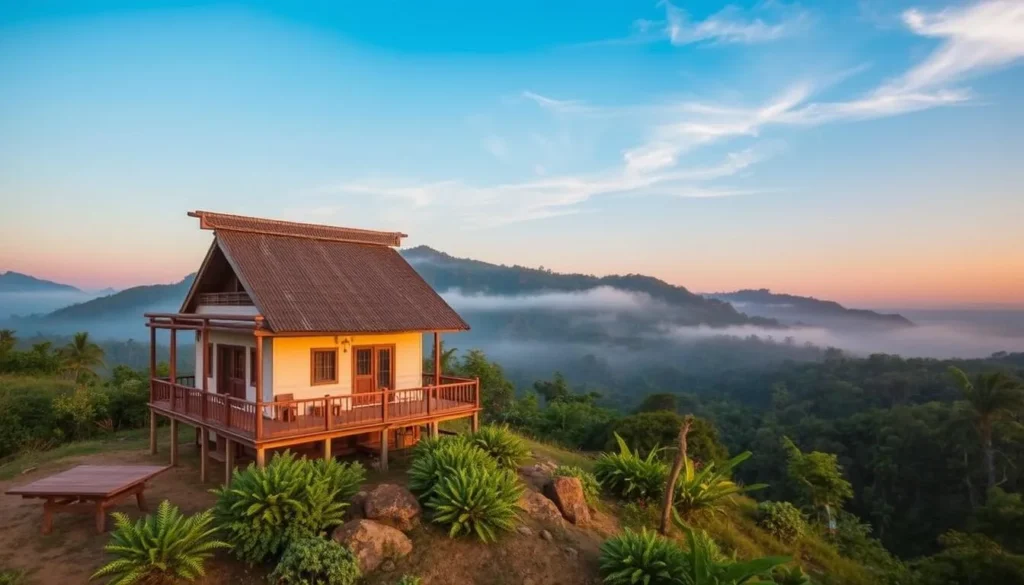
When planning your trip to the Cardamom Mountains, choosing the right accommodation is crucial for a comfortable and enjoyable adventure. The region offers a variety of options to suit different preferences and budgets.
Eco-Lodges and Luxury Camps
For a luxurious experience, eco-lodges and luxury camps are available, offering high-end amenities while maintaining a minimal environmental footprint. These accommodations provide a comfortable stay amidst the nature and beauty of the Cardamom Mountains.
Community Homestays
Community homestays offer a unique opportunity to experience local culture and hospitality. By staying with local families, you can gain insight into traditional ways of life and contribute to the community’s economic development.
Camping Options
For a true wilderness experience, camping is an exciting option. You can bring your own gear or rent equipment from tour operators. Authorized jungle campsites are available near popular waterfalls and trekking trails, offering an immersive adventure in the Cardamom Mountains. Camping is ideal for stargazing and nocturnal wildlife encounters, but should always be done with an experienced guide. Some guides provide full-service camping treks, including gear and meals, for 1-2 night trips.
Whether you choose an eco-lodge, community homestay, or camping, your stay in the Cardamom Mountains is sure to be an unforgettable experience.
Cultural Experiences and Local Communities
In the Cardamom Mountains, you’ll find not only a haven for wildlife but also a treasure trove of cultural traditions and community life. This region is home to indigenous villages where you can experience the rich heritage of Cambodia’s native communities.
Indigenous Villages and Traditions
Visiting the indigenous villages in the Cardamom Mountains offers a unique glimpse into traditional ways of life. You can engage with local communities by learning about their customs, such as traditional crafts and farming practices. When interacting with these communities, it’s essential to be respectful of their traditions. For instance, dressing modestly and removing your shoes before entering homes or community buildings are simple gestures that show respect. You can also learn basic Khmer greetings like “Chum Reap Suor” (hello) and “Orkun” (thank you), which can help build rapport with the locals.
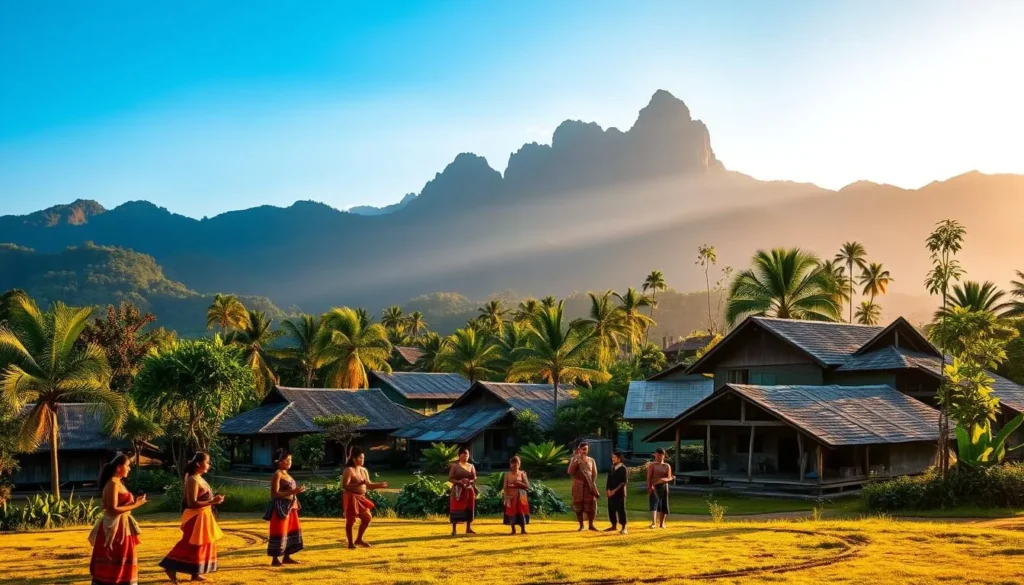
Responsible Tourism Tips
As you explore these areas, practicing responsible tourism is crucial. This includes choosing tour operators with clear conservation commitments, such as those employing former hunters as guides. You should also support the local economy by purchasing handicrafts directly from artisans and using local guides. Additionally, always ask permission before taking photographs of people, especially in remote communities or during ceremonies. Following Leave-No-Trace principles by minimizing your impact on sensitive natural areas and packing out all trash is also vital. Consider contributing to reputable conservation organizations working in the Cardamoms to support the long-term protection of this significant wilderness area.
By being mindful of your actions and their impact, you can help preserve the cultural integrity and natural beauty of the Cardamom Mountains, making your visit a positive experience for both you and the local communities.
Conclusion: Preserving the Cardamom Mountains for Future Generations
Cambodia’s Cardamom Mountains are not just a travel destination, but a chance to be part of a conservation effort that protects one of Southeast Asia’s last great wilderness areas. As you plan your visit, you’re contributing to the preservation of this remarkable region, known for its rich biodiversity and ecological significance.
The Cardamom Mountains play a crucial role in supporting local communities and maintaining Cambodia’s water systems, including the vital Tonle Sap lake. Conservation organizations, alongside Cambodia’s Ministry of Environment, are working tirelessly to protect this ecosystem through initiatives like anti-poaching patrols and habitat restoration.
By choosing eco-friendly accommodations and tour operators, you directly support conservation efforts and local economies. As you explore the Cardamom Mountains, from the misty peaks of Phnom Aural to the mangrove forests of Koh Kong, you’ll experience the true essence of Cambodia’s natural heritage. The time you spend here will not only leave you with unforgettable memories but also contribute to the long-term preservation of this incredible destination.
As the world grapples with climate change, the Cardamom Mountains stand out as a vital carbon sink and wildlife refuge. Your visit can make a difference, supporting the protection of endangered species and the ecosystems they inhabit. The Cardamom Mountains are a treasure worth preserving for future generations.
The above is subject to change.
Check back often to TRAVEL.COM for the latest travel tips and deals.
